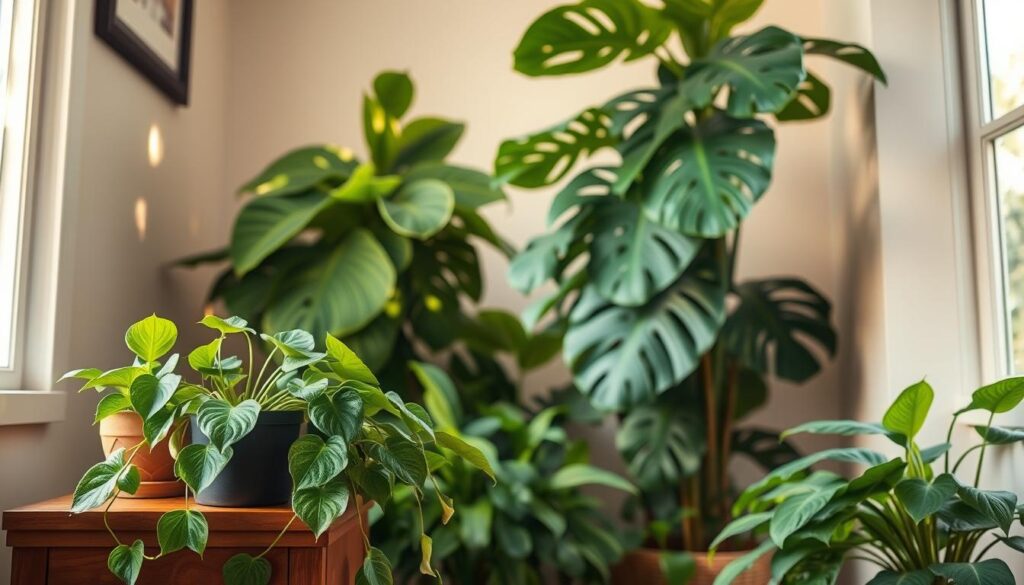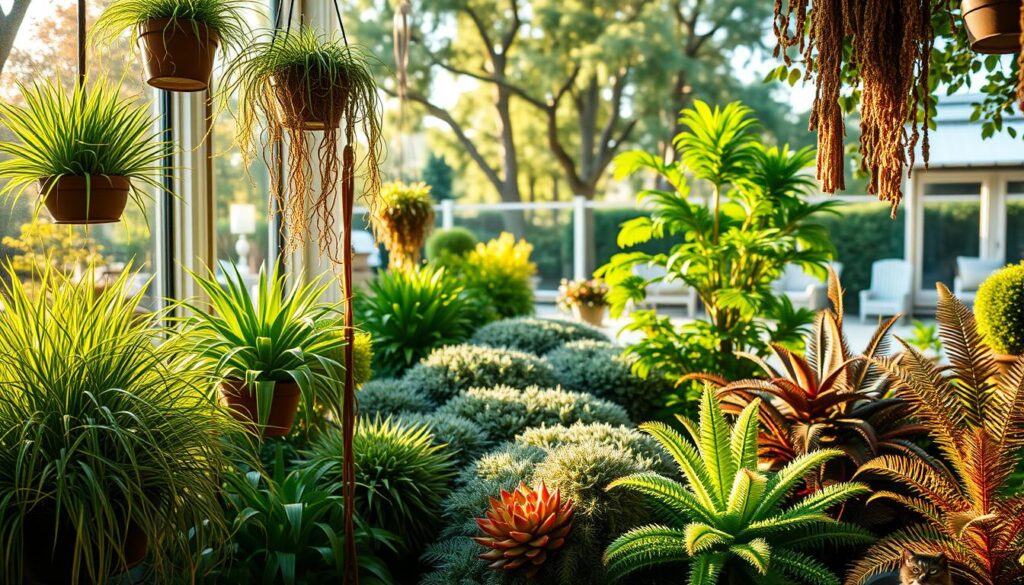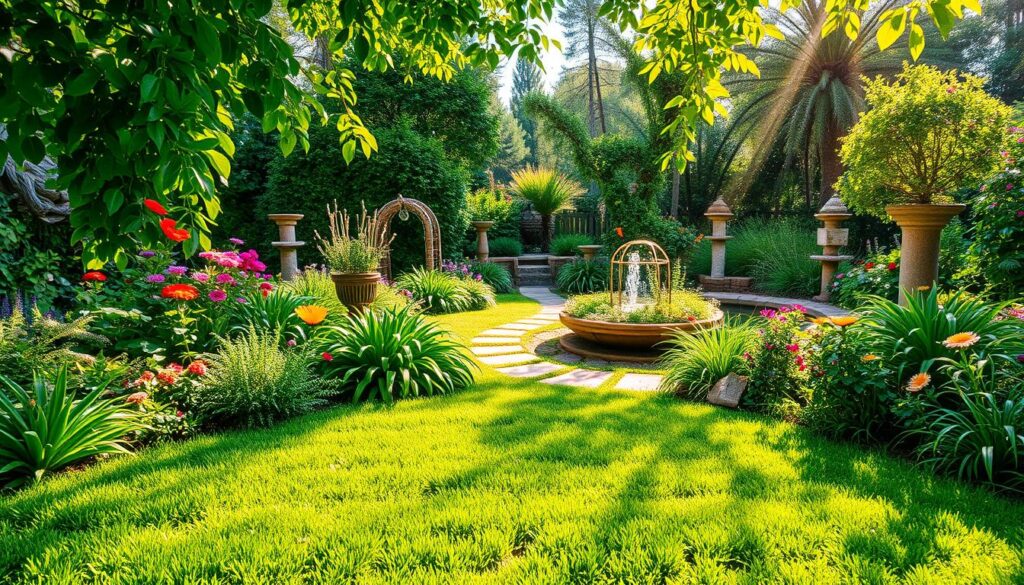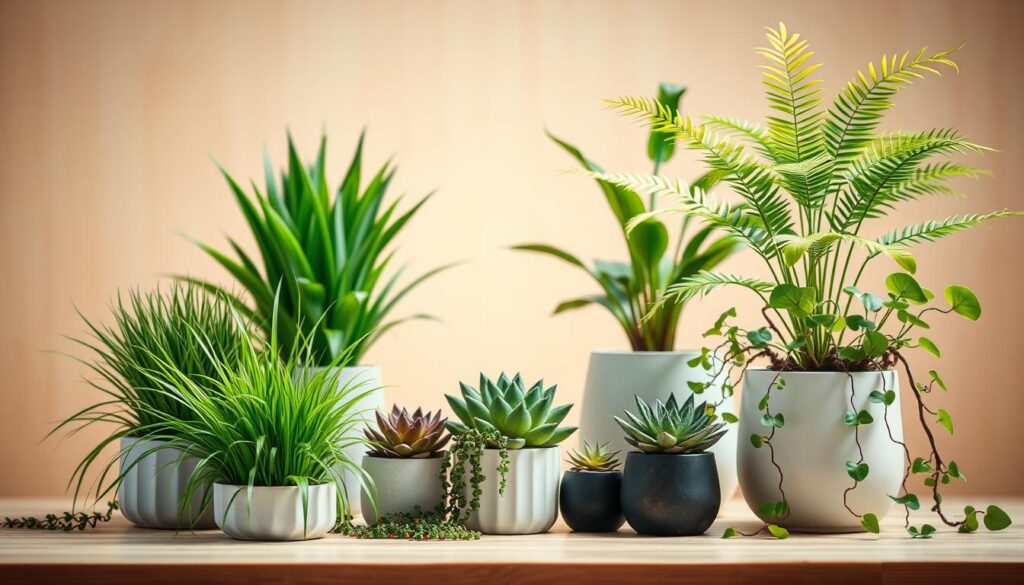As a cat owner, you want to create a beautiful and safe home for your feline friend. With over 34 approved cat-safe houseplants listed, you can choose from a variety of non-toxic plants for cats that are perfect for your home. All of these cat-friendly plants have low watering needs and drought tolerance, making them easy to care for. You can select from a range of plants, from the small Zebra Plant to the tall Parlor Palm, to bring some greenery into your home without worrying about your cat’s safety.

When it comes to cat safe plants, it’s essential to choose plants that are non-toxic to cats and dogs. With 100% of the listed plants being safe for both cats and dogs, you can have peace of mind knowing that your pets are protected. From the Spider Plant to the Boston Fern, there are many cat-friendly plants that can add a touch of elegance to your home without posing a risk to your feline friend.
Table of Contents
Why Choose Cat Safe Plants for Your Home?
When it comes to decorating your home, you want to ensure that the plants you choose are not only beautiful but also safe for your feline friends. With approximately 70% of commonly sold house plants being toxic to cats, selecting pet-safe plants is crucial for pet owners. Feline-friendly foliage can bring numerous benefits to your home, including air purification and aesthetic appeal.

Some popular safe plants for cats include spider plants, Boston ferns, and parlour palms. These plants are not only non-toxic to cats but also easy to maintain and care for. For example, spider plants are known to thrive in a variety of lighting conditions and can be watered approximately every week in the summer.
In addition to their safety and low maintenance, pet-safe plants can also improve the air quality in your home. The Boston fern, for instance, is recognized by NASA as one of the top 10 air-purifying plants. By choosing feline-friendly foliage, you can create a healthy and welcoming environment for both you and your cat.
Some benefits of safe plants for cats include:
* Air purification
* Aesthetic appeal
* Low maintenance
* Non-toxic to cats
By selecting pet-safe plants, you can enjoy the benefits of indoor plants while keeping your feline friends safe and healthy.
Popular Cat-Safe Plants for Your Home
When it comes to choosing plants that are safe for your feline friends, there are many options to consider. You want plants that are easy to care for and can thrive in a variety of environments. Some popular cat-friendly indoor plants include the spider plant, Boston fern, and Areca palm. These plants are not only safe for your cats but also help purify the air and add a touch of greenery to your home.
One of the benefits of having cat-safe plants is that they can help reduce stress and anxiety in your home. Plants like the spider plant and Boston fern are known to be calming and can help create a peaceful atmosphere. Additionally, plants like the Areca palm are great air purifiers, making them a great choice for indoor spaces.
Spider Plant: A Lively Addition
The spider plant is a popular choice for cat owners because it is easy to care for and can thrive in a variety of lighting conditions. It is also a great air purifier, making it a great choice for indoor spaces.
Boston Fern: A Safe and Stylish Choice
The Boston fern is a stylish and safe choice for cat owners. It prefers humid conditions and bright, indirect light, making it a great choice for bathrooms and other areas with high humidity.
Areca Palm: A Great Air Purifier
The Areca palm is a great air purifier and is safe for your cats. It is also relatively low maintenance, making it a great choice for busy pet owners.
Some other cat-safe outdoor plants include the parlor palm and staghorn fern. These plants are adaptable to different environments and can thrive in outdoor conditions.

When choosing plants that are safe for your cats, it’s essential to do your research and choose plants that are non-toxic. Some plants, like the peace lily and jade plant, can be toxic to cats and cause symptoms like vomiting and depression.
| Plant | Toxicity | Care Requirements |
|---|---|---|
| Spider Plant | Non-toxic | Easy to care for, can thrive in a variety of lighting conditions |
| Boston Fern | Non-toxic | Prefers humid conditions and bright, indirect light |
| Areca Palm | Non-toxic | Relatively low maintenance, great air purifier |
By choosing cat-friendly indoor plants and cat-safe outdoor plants, you can create a safe and healthy environment for your feline friends. Remember to always do your research and choose plants that are non-toxic to ensure your cat’s safety and well-being.
How to Select Cat-Friendly Plants
When choosing plants for your home, it’s essential to research their toxicity and consider your cat’s behavior to ensure their safety. You can start by reading labels and doing research before bringing a new plant into your home. Look for non-toxic plants for cats that are specifically labeled as pet-safe plants or feline-friendly foliage.
Some ways to research plant toxicity include checking the ASPCA’s list of toxic and non-toxic plants, consulting with a veterinarian or a plant expert, and reading reviews from other pet owners. You can also consider your cat’s behavior and personality when choosing plants. For example, if your cat is prone to nibbling on plants, you may want to choose plants with bitter tastes or textures that will deter them from eating.

- Choose plants that are specifically labeled as non-toxic plants for cats or feline-friendly foliage.
- Research the plant’s toxicity and potential health risks to cats.
- Consider your cat’s behavior and personality when choosing plants.
- Keep plants out of reach of your cat to prevent accidental ingestion.
| Plant | Toxicity | Safety |
|---|---|---|
| Catnip | Non-toxic | Pet-safe |
| Spider Plant | Non-toxic | Pet-safe |
| True Lily | Toxic | Not pet-safe |
Understanding Plant Toxicity
As a cat owner, it’s essential to be aware of the potential risks that certain plants can pose to your feline friend. Some plants contain toxic compounds that can be harmful to cats, and it’s crucial to know the common symptoms of plant poisoning. Cat safe plants and cat-friendly plants are great alternatives to toxic plants that can harm your pet.
According to statistics, toxic plant ingestions are not frequent but are also not rare, with most veterinarians seeing a handful of cases each year. The most common symptoms from toxic plant ingestions include vomiting, nausea, and diarrhea, which can affect up to 40% of cases involving pets. Certain plants can result in more severe symptoms such as abnormal heart rhythms, sedation, tremors, seizures, and kidney or liver failure.
Why Some Plants Are Toxic to Cats
Cats are significantly more susceptible to kidney failure and death from ingesting any part of a lily plant, with a high incidence rate observed amongst feline patients. It is advised to consult a vet if a pet ingests a plant, regardless of current health, due to the potential for delayed symptoms, which can occur in 25% or more cases.
Common Symptoms of Plant Poisoning
Symptoms of plant toxicity often include localized irritation leading to redness, swelling, or itchiness of the skin, mouth, or eyes. Gastrointestinal irritation from toxic plants may result in vomiting and diarrhea, with specific symptoms depending on the organ affected. Immediate care can be critical, as some poisonings can be fatal, particularly if care is delayed.

For identification and treatment, knowledge of over 10 common plants poisonous to pets is essential, as listed by resources like the Pet Poison Helpline and the ASPCA. Veterinarians may need to conduct blood tests to determine the overall health impacts caused by a poisonous plant ingestion. By being aware of the potential risks and taking necessary precautions, you can help keep your cat safe and healthy.
| Plant | Toxicity Level | Symptoms |
|---|---|---|
| Lily | High | Kidney failure, death |
| Amaryllis | Moderate | Vomiting, diarrhea |
| Azaleas | Moderate | Abnormal heart rhythms, sedation |
Tips for Introducing Plants to Your Home
When introducing new plants to your home, it’s essential to do so gradually and observe your cat’s reaction to ensure their safety. This is especially important when it comes to cat-friendly indoor plants, as some cats may be more curious than others. By introducing plants slowly, you can help prevent any potential harm to your cat and create a harmonious environment for both your feline friend and your new greenery.
Some cat-safe outdoor plants can also be brought indoors, providing a beautiful and safe addition to your home. However, it’s crucial to research the specific plant species to ensure it’s non-toxic to cats. Introducing plants to your home can be a wonderful way to purify the air, improve the aesthetic, and even provide your cat with a natural and stimulating environment.

- Start with small, non-toxic plants and observe your cat’s reaction.
- Gradually introduce new plants, one at a time, to prevent overwhelming your cat.
- Keep an eye on your cat’s behavior around plants, and remove any plants that may be causing harm or stress.
By following these tips and choosing cat-friendly indoor plants, you can create a beautiful and safe environment for both you and your feline companion.
Plant Care Tips for Cat Owners
When it comes to caring for your cat-friendly plants, it’s essential to choose non-toxic fertilizers and avoid using harmful chemicals. This ensures your cat’s safety while enjoying the benefits of indoor plants. With over 34 varieties of ASPCA-approved non-toxic houseplants for cats, you can select the perfect plants for your home.
Some popular cat-friendly plants, such as the Spider Plant and Boston Fern, are not only safe for your cat but also offer air-purifying benefits. To care for these plants, consider the following plant care tips:
- Use non-toxic fertilizers to promote healthy growth
- Water plants according to their specific needs, as overwatering can be harmful
- Provide the right amount of light, as most cat-friendly plants prefer full sun to partial shade
By following these plant care tips and choosing non-toxic fertilizers, you can create a safe and healthy environment for both your cat and your plants. Remember, approximately 70% of common houseplants can be toxic to pets, so it’s crucial to select cat-friendly plants and care for them responsibly.

| Plant | Toxicity | Cat-Friendly |
|---|---|---|
| Spider Plant | Non-Toxic | Yes |
| Boston Fern | Non-Toxic | Yes |
| Peace Lily | Toxic | No |
Creating a Cat-Friendly Garden
When designing a garden, it’s essential to consider your cat’s safety and create a cat-friendly environment. This includes choosing cat-safe outdoor plants and taking outdoor considerations for cat safety into account. A well-designed garden enclosure can reduce outdoor risks for cats by 90% when implemented with proper fencing and supervision.
To create a cat-friendly garden, you should avoid plants that are toxic to cats, such as lilies, azaleas, and rhododendrons. Instead, opt for cat-safe outdoor plants like catnip, catmint, and cat grass. You can also incorporate secured logs and climbing frames to enhance feline engagement and activity levels.
Here are some tips for creating a cat-friendly garden:
- Choose cat-safe outdoor plants and avoid toxic ones
- Incorporate secured logs and climbing frames
- Provide shade and hydration
- Create a designated area for elimination
By following these tips, you can create a cat-friendly garden that is safe and enjoyable for your feline friend. Remember to always prioritize your cat’s safety and well-being when designing your outdoor space.

| Plant | Toxicity |
|---|---|
| Catnip | Non-toxic |
| Catmint | Non-toxic |
| Cat grass | Non-toxic |
By choosing the right plants and taking outdoor considerations for cat safety into account, you can create a beautiful and safe cat-friendly garden.
Alternatives to Toxic Plants
As a cat owner, it’s essential to be aware of the toxic houseplants that can harm your feline friend. Fortunately, there are many beautiful non-toxic plant options available that can replace toxic houseplants. By choosing non-toxic plants for cats, you can create a safe and healthy environment for your pet to thrive.
Some common toxic houseplants include Lilies, Sago Palms, and Snake Plants. These plants can cause a range of symptoms in cats, from mild vomiting to severe kidney failure. On the other hand, beautiful non-toxic plant options like Spider Plants, Parlor Palms, and Nerve Plants are safe for your cat to be around.
Identifying Common Toxic Houseplants
It’s crucial to identify common toxic houseplants to avoid bringing them into your home. Some plants, like Peace Lilies and Pothos, may cause mild symptoms, while others, like true Lilies, can be highly toxic. By being aware of the plants that are toxic to cats, you can make informed decisions when selecting plants for your home.
Beautiful Non-Toxic Plant Options
There are many beautiful non-toxic plant options available that can add a touch of greenery to your home without putting your cat at risk. Some popular options include:
- African Violets
- Chinese Money Plants
- Bird’s Nest Ferns
- Bamboo
- Cast Iron Plants
These plants are not only safe for your cat but also easy to care for and maintain. By choosing non-toxic plants for cats, you can create a harmonious and healthy environment for both you and your pet.

How to Train Your Cat Around Plants
Training your cat to behave around plants is essential to ensure their safety and the safety of your plants. Approximately 60% of cat owners report that their cats show an interest in houseplants, leading to destructive behavior. To address this issue, it’s crucial to use distraction techniques and positive reinforcement for good behavior.
Some effective distraction techniques include using a water pick as a deterrent, which has a 75% success rate in retraining cats not to interact with plants. Consistent training techniques can lead to long-term effectiveness in behavior modification. It’s also important to choose cat-friendly plants, such as catnip or lemongrass, which can provide a safe and stimulating environment for your cat.
Here are some tips for training your cat around plants:
- Start with short training sessions and gradually increase the duration
- Use positive reinforcement, such as treats and praise, for good behavior
- Provide alternative scratching posts and toys to distract your cat from plants
By following these tips and using distraction techniques, you can help train your cat to behave around plants and create a safe and harmonious environment for both your cat and your plants.
| Plant | Toxicity | Safety |
|---|---|---|
| Catnip | Non-toxic | Safe for cats |
| Lemongrass | Non-toxic | Safe for cats |
| Spider Plant | Mildly toxic | Use caution |
Designing a Cat-Friendly Indoor Space
When designing a cat-friendly indoor space, it’s essential to incorporate cat-safe plants and stylish planters that are cat-proof. This will not only ensure your cat’s safety but alsoacentuate the aesthetic appeal of your home. You can choose from a variety of cat-friendly indoor plants that are non-toxic to cats, such as the Parlour Palm or Peperomia.
To create a harmonious and safe environment, consider the following tips:
- Place cat-safe plants in areas where your cat tends to spend most of its time.
- Use stylish planters that are stable and won’t tip over easily.
- Avoid using plants with toxic substances, such as eucalyptus or hydrangeas.
By incorporating cat-friendly indoor plants and stylish planters into your decor, you can create a beautiful and safe space for your feline friend to enjoy. Remember to always research the toxicity of any plant before bringing it into your home, and opt for cat-safe plants that will provide a healthy and happy environment for your cat.
| Plant Name | Toxicity Level | Cat-Friendly |
|---|---|---|
| Parlour Palm | Non-toxic | Yes |
| Peperomia | Non-toxic | Yes |
| Eucalyptus | Toxic | No |
Frequently Asked Questions About Cat-Safe Plants
As a cat owner, you may have frequently asked questions about cat-safe plants. Identifying cat-friendly plants is crucial to ensure your pet’s safety. With so many plants being toxic to cats, it’s essential to choose the right ones for your home.
Some cat-safe plants include Alstroemeria, Gerbera daisies, and Orchids. You can also consider the Areca palm, Boston fern, and Spider plant, which are all non-toxic to cats. When identifying cat-friendly plants, look for plants that are safe for your cat to be around, such as cat grass, which is the safest plant for cats.
To keep your cat safe, it’s also important to keep plants and flowers out of their reach. You can also consider alternatives like cat grass to redirect your cat’s chewing behavior away from houseplants. By choosing cat-safe plants and taking the necessary precautions, you can create a safe and happy environment for your cat.
For more information on cat-safe plants and how to identify them, you can consult with a veterinarian or a plant expert. They can provide you with a list of cat-friendly plants and help you choose the best ones for your home. Remember, your cat’s safety is the top priority, so always prioritize cat-safe plants when decorating your home.
Resources for Further Research on Cat-Safe Plants
As you strive to create a safe and vibrant home environment for your feline friend, exploring reliable resources on cat-safe plants is crucial. From comprehensive books to informative websites, there are numerous avenues to deepen your understanding of which greenery is suitable for your cat’s well-being.
Books and Guides on Pet Safety
Several authoritative publications offer valuable insights into pet-friendly landscaping and indoor plant selection. “The Cat-Safe Garden” by Tovah Martin and “Cats, Cats, Cats: A Complete Guide to Cat Care and Cat Care Products” by Consumers Union provide in-depth guidance on identifying and caring for cat-safe plants. These resources can serve as essential references for any cat owner seeking to create a harmonious, plant-filled home.
Websites with Reliable Plant Information
Online platforms like the ASPCA’s Toxic and Non-Toxic Plant List offer a comprehensive database of plant safety for various pets, including cats. This resource allows you to search by plant name or type to determine if a particular species is considered non-toxic or potentially harmful to your feline companion. Exploring these digital tools can help you make informed decisions when selecting plants for your home.
FAQ
What makes a plant safe for cats?
Cat-safe plants are those that do not contain toxic compounds that can be harmful to felines. These plants are non-toxic and do not pose a threat to your cat’s health when ingested or came into contact with.
How can I identify cat-friendly plants?
When choosing plants for your home, look for those that are specifically labeled as “cat-safe” or “non-toxic to pets.” Additionally, you can research the specific plant species to ensure they are not known to be poisonous to cats.
What are some common toxic houseplants that I should avoid?
Some common toxic houseplants to avoid include lilies, poinsettias, dieffenbachia, and azaleas. These plants can be highly poisonous to cats if ingested, so it’s best to steer clear of them in a pet-friendly home.
How can I train my cat to behave around plants?
Positive reinforcement and distraction techniques can be effective in training your cat to leave plants alone. Provide your cat with engaging toys or catnip-filled distractions when they approach the plants, and praise or reward them when they exhibit good behavior.
What are some tips for incorporating cat-safe plants into my home decor?
When designing a cat-friendly indoor space, choose plants that are placed in sturdy, cat-proof planters to discourage your feline from climbing or knocking them over. Opt for plants that are known to be non-toxic and that can thrive in well-lit areas your cat enjoys.
Where can I find more resources on pet-safe plants and plant toxicity?
There are many reliable websites and books that provide comprehensive information on cat-safe plants, plant toxicity, and pet safety. Consult resources from veterinary organizations, plant databases, and pet-focused gardening guides to ensure you make informed choices for your home.
Source Links
- Cat-Friendly Plants ‘Top 34 Nontoxic & Easy-Care’ Varieties! – https://planetdesert.com/blogs/news/cat-friendly-plants-top-34-easy-to-care-for-nontoxic-varieties?srsltid=AfmBOoo_tMY-cfngpurfs922waBKDaz1ecClO8m-YtyMYwkmZJWyunOz
- Pet Friendly House Indoor Plants For Cats & Dogs | Lively Root – https://www.livelyroot.com/collections/pet-friendly-plants?srsltid=AfmBOorWJk7hxy4yBf3jIUCL2Cct_Oo5COZNpd51vZ1fnLMoaFJCqoMd
- 10 Cat-Safe Plants that are Also Hard to Kill – https://www.meowbox.com/blogs/news/10-cat-safe-plants-that-are-also-hard-to-kill?srsltid=AfmBOorFfaZS3kk-HkC1XuL-nMQ-kwTHovOu5yTeqnTiA3u4AgTi81-q
- 22 Pet-Friendly Plants That Will Liven Up Your Space – https://www.architecturaldigest.com/story/pet-friendly-houseplants
- 18 cat-friendly house plants – https://www.gardenersworld.com/house-plants/plants-cat-friendly-houseplants/
- 15 Low Maintenance Plants that are Safe for Cats ⋆ [2025 ] – https://www.lifescarousel.com/cat-safe-plants/
- 26 Pet-Friendly Houseplants Safe for Cats and Dogs – https://www.thespruce.com/safe-houseplants-for-pets-4588752
- Cat Friendly Plants (and Which Ones to Avoid) – https://www.zoetispetcare.com/blog/article/cat-friendly-plants
- Cat-Safe House Plants – https://sienaanimalhospital.com/articles/892306-cat-safe-house-plants
- The Sill | Plant Toxicity and Pet Safety According to a Veterinarian – https://www.thesill.com/blogs/plants-101/plant-toxicity?srsltid=AfmBOop97i71-G0YZ6GI0TdOgOuTIjlv1HmoWl2_l0OWM-TBsX9RkNvm
- Poisonous Plants for Cats – https://www.petmd.com/cat/emergency/poisoning-toxicity/e_ct_poisonous_plants
- 7 Cat-Safe Indoor Plants | Cat Behavior | Meowtel – https://meowtel.com/blog/post/7-cat-safe-indoor-plants
- Creating a Safe Haven: Cat-Friendly Plants – https://plantologyusa.com/blogs/the-plantologist/plants-that-are-safe-for-cats?srsltid=AfmBOoq5uxr-2Lm51A7KJqfysyLFZ0JNF-xlVkPCgkb4Ah8Yl2vCGGyY
- 20 House Plants Safe for Cats – https://www.catastrophicreations.com/blogs/articles/house-plants-safe-for-cats?srsltid=AfmBOooGJgxX7GKKmRGIT7VOfBaWTioMs-QsOaURy4ZuQppkbT5yPfkI
- Cat-Friendly Plants ‘Top 34 Nontoxic & Easy-Care’ Varieties! – https://planetdesert.com/blogs/news/cat-friendly-plants-top-34-easy-to-care-for-nontoxic-varieties?srsltid=AfmBOoopcRtp7PTgtvPW-5GxoZ_oP-yUrd1DOkxrD2YgUHYD8p238fVj
- How to Fill Your Home with House Plants that are Safer for Cats – https://catsinthecity.com/how-to-fill-your-home-with-house-plants-that-are-safer-for-cats/
- 7 Ways to Make a Cat-Friendly Garden – https://lawnlove.com/blog/ways-to-make-a-cat-friendly-garden/
- How to create a cat-friendly garden – https://www.gardenersworld.com/plants/how-to-create-a-cat-friendly-garden/
- Petscaping: Creating a Pet-Friendly Garden – https://extension.psu.edu/petscaping-creating-a-pet-friendly-garden
- A Comprehensive Guide to Toxic Plants and Pet-Friendly Alternatives – https://animalemergencyservice.com.au/blog/a-guide-to-toxic-plants-and-pet-friendly-alternatives/
- Toxic Tropical Plants to Cats… and Safe Alternatives Too! – https://tropicalplantsofflorida.com/toxic-tropical-plants-to-cats/?srsltid=AfmBOoohPYBcXCC9s-u1ATAM_ezRcJhsn2vNg7ffk7YcDKyfv1n6xYQ7
- 10 Indoor Plants That Are Safe for Cats—and Easy To Care For – https://www.realsimple.com/cat-safe-plants-8665026
- Cats and Plants – How I trained my cats, yes – trained them! — She Wears The Plants – https://www.shewearstheplants.com/blog/cats-and-plants-how-i-trained-my-cats
- A cat-safe garden of non-toxic plants your cats will love. – https://www.chirpycats.com/cat-safe-cat-garden/
- Jakie rośliny doniczkowe są bezpieczne dla kota » Apollo Fluffy Cat | Blog about cats and eco-friendly living – https://apollofluffycat.com/en/cat-friendly-indoor-houseplants-for-beginners/
- Green Fingers | The prettiest Cat-Safe House Plants – Design Soda: Interiors Blog | Colour, Pattern, Patina – https://designsoda.co.uk/cat-safe-plants/
- 31 Cat-Safe Plants and Flowers – https://www.petmd.com/cat/general-health/plants-safe-for-cats
- Houseplants Safe for Cats | Indoor Plants Non-Toxic to Cats – https://allaboutplanties.com/blogs/plant-care-tips/houseplants-that-are-safe-for-cats-a-guide-for-pet-owners?srsltid=AfmBOooSXuEqjWkBc3fElbZue1DDljUlgGeyG1wYegq-ozNuN3GTR5dQ
- Cat-Safe Plants: Cultivating Feline-Friendly Havens – https://plantologyusa.com/blogs/the-plantologist/cat-safe-plants-cultivating-feline-friendly-havens?srsltid=AfmBOoo12mw9PnT8pjljDr33J8yBYqVLFMs8hqoXCKGZNX38VHalgU_D
- Plants safe for dogs and cats – https://www.animalhealthfoundation.org/blog/2023/10/plants-safe-for-dogs-and-cats/
- Finding Safe Plants For Cats – Happier Houseplants – https://happierhouseplants.com/safe-plants-for-cats/


1 thought on “Cat-Friendly Plants: Keeping Your Feline Safe at Home”